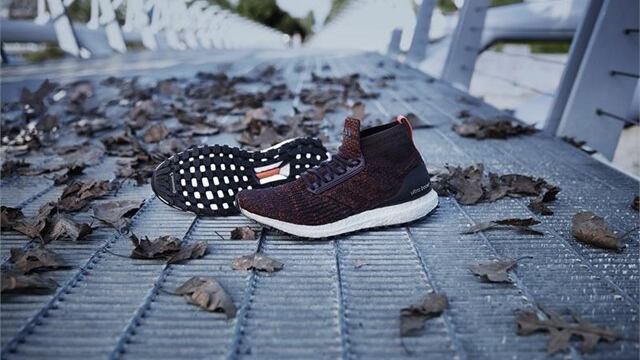Adidas' Ultra Boost is one of the best sneakers on the market.
Since Kanye West's performed in an entirely white pair of the sneakers at the Billboard Music Awards back in 2015, the Ultra Boost has blurred the line between fashion and performance sneaker more than few others. It's understated silhouette, simple colorways and woven Primeknit upper makes it the most stylish performance running sneaker made in recent memory (especially when worn with track pants). Most importantly, of the dozens of pairs of shoes I've worn in the past couple years, the Ultra Boost is decidedly the most comfortable. The full length Boost foam-lined sole kinda looks like you're walking on styrofoam. It feels like you're walking on memory foam.
But the original low top iteration of the Ultra Boost retails at a hefty $180, in the upper price echelons of performance running shoes and certainly closer to luxury sneaker pricing than casual. Now, how would you feel if you added on an ankle sock and $40 to the price tag?

Well, Adidas did just that with the Ultra Boost All Terrain (ATR) released back in September of this year. Billed as a fall and winter weather-variant of the Ultra Boost, the ATR sports an ankle-height sock for increased stability and splash protection, plus a deeper-grooved rubber outsole for better traction while running in wet weather. The original's plastic lace cage is replaced with Primeknit fabric, plus a smaller box that sits atop the shoe. Finally, the ATR comes in darker colorways—grey, charcoal/black and red/black—so as to not show winter muck after a damp run. Adidas sent me a pair to review, so I took them not only to the damp streets of Portland, but to the streets of New York.
The original Ultra Boost is an extremely popular fashion sneaker, and new colorways are regularly sold out online and in store (check Portland's INDEX for rare pairs!). The ATR keeps the original's subdued aesthetics, but the midtop construction adds a new design element which I think makes the sneaker well-suited for styling with jeans as well as athleticwear.
As for the on-foot feel, the ATR is comfortable, but not quite as comfortable as the original Ultra Boost. Though the ATR's tougher sole provides better traction than the original it leads to an on-foot feeling that isn't quite as heavenly.
Further, the shoe feels slightly tighter-fitting and more socklike than the original. The ankle sock doesn't overheat the foot, but when tied tight, the tops of my feet develop a pinchy feeling after a few hours that doesn't occur when left untied (the laces don't reach the ground) or tied loosely.

As far as long-term wear goes, I took my ATRs to the streets of New York on a recent trip to test them out. They held up nicely during what I'd consider an everyday amount of activity (~2-3 miles of walking broken up with extended sitting breaks), my feet not getting particularly sore despite a long stroll through Prospect Park. But on two particularly grueling days, the first, an hours-long punk show on wood and concrete floors, and the second, a long day shopping in Manhattan (At least 5 miles, mostly on foot), my dogs were certainly barkin' when I returned home. Though I don't consider those days representative of normal use, the ATR, despite above-average comfort, is not a miracle worker.
Now, what about actually running in my running shoes? I'm not a hardcore or regular runner: My cardiovascular health is slightly above average at best, but I can put away 5 kilometers without trouble, and I did just that on the treadmill and on Portland's waterfront.
On the treadmill, the ATR provided a solid, comfortable ride. Perhaps it is because running on a treadmill is excruciatingly boring, but I found myself paying more attention to my body during this run, and I noted that the ankle sock kept my feet feeling more secured than with my normal low top running shoe (Adidas' AlphaBounce).
However, the ATR really shined when running outside on a blustery November evening. I ran on the southwest waterfront, partially down the Eastbank Esplanade and back on a damp day. It wasn't raining, but it had rained plenty earlier, and the path was slick and covered with fallen leaves.
And I just completely disappeared into my run. Maybe it was because the Old Town sign was extra-glittery that evening, but, as one wants when on a fairly intense run, I barely noticed the shoes on my feet as I jogged along the Willamette. I had no issues with tightness, and the traction was excellent along wet concrete and the ostensibly slick floating metal bridge of the Esplanade. The only thing I really noticed was a slight bounce between my foot and the sole as I ran.
Now, is all of this worth the $220 price tag? If your running shoe or fashion sneaker budget is high, then $220 nabs you a stylish, high-performing variant on a cool sneaker that'll help you push through Portland's blusteriest winter days. Yet, if you aren't committed to winter running, $220 is a high price to pay for a sneaker that mostly just looks cool. As someone who gets my cardio in elsewhere, I wouldn't personally spend the $220 on a performance shoe which I am not using for its intended purpose.
Then again, I will be taking my next few runs to the streets in my ATRs as long as it isn't raining sideways.
(Cool Stuff is a new feature at Willamette Week where we feature product reviews, roundups, sales and other commerce and shopping-oriented content. All Cool Stuff reviews are editorially independent, meaning we provide honest reviews and aren't paid by the brands we write about. If you do choose to purchase something after following one of our links, Willamette Week may receive a commission, which helps fund our journalism.)

